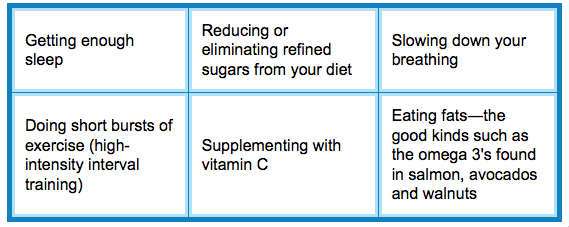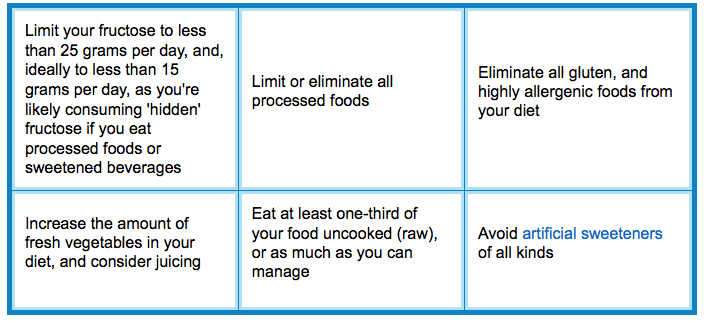How to Get a Flat Belly Without Exercise
How to Get a Flat Belly Without Exercise
If you’re looking to shrink and tone your belly, there’s a better way to do it than trying to do crunches. In fact, research has shown that doing abdominal exercises alone—even when performed five days a week for six weeks—has no effect at all on subcutaneous fat stores and abdominal circumferencei.
In an op-ed piece for Forbes Magazine, Jennifer Cohen suggests using strategies that burn up cortisol instead. Cortisol is a hormone in your body that depletes lean muscle and holds on to fat in the abdominal region.
One of the most important ways to help this process is to reduce stress in your life, because stress causes cortisol levels to spike. Cohen also delves into a number of other strategies that help reduce your cortisol levels, such as the following:

The KEY Strategy for Reducing Belly Fat
Cohen certainly brings up some good points. Getting sufficient amounts of sleep, for example, not only helps normalize cortisol levels, it’s also important in order to optimize your circadian clock, which can have a profound impact on your metabolism and weight. As an example, a couple of years ago researchers at the University of Chicago found that dieters who slept for 8.5 hours lost 55 percent more body fat over the course of two weeks than dieters who only got 5.5 hours of sleep a night.ii
But the master key really lies with your diet, followed closely by the type of exercise you engage in.
About 80 percent of your ability to reduce excess body fat is determined by what you eat, with the other 20 percent related to exercise and other healthy lifestyle habits such as sleep and stress reduction. What this means is that if your diet is based on sugar/fructose and processed junk food, your chances of getting flat, ripped abs, even if you work out religiously, are quite slim…
You simply will not see defined abs unless you reduce your overall body fat, and a poor diet cause your body to hold on to excess fat, despite all your exercise efforts. Cohen mentions two of the most important dietary factors in her article, namely:
Reducing or eliminating sugar from your diet. This includes ALL forms of sugar and fructose, whether refined or “all-natural” such as agave or honey, as well as all grains (including organic ones), as they quickly break down to sugar in your body
Increasing healthful fats in your diet, such as healthy saturated fats and animal-based omega-3’s
One of the most pernicious dietary influences on your weight loss goals is fructose, which hides in so many processed foods and beverages, it can be near impossible to avoid unless you alter your shopping and cooking habits. By avoiding processed foods in general, and focusing instead on whole, preferably locally grown organic foods, cooked at home, you can circumvent one of the greatest dietary obstacles there is today.

The Primary, and the Most Surprising, Dietary Offenders
Fructose, primarily in the form of high fructose corn syrup hidden in processed foods and beverages is the primary contributing factor to widespread and seemingly out-of-control obesity. The top offenders in this category include:

There are also a number of foods that are typically considered healthy that you might not suspect would contribute to your weight problem. But while considered “healthy” by the mainstream, these foods are actually loaded with sugar and/or fructose:

What’s the Best Fat-Busting Exercise?
Once you’ve addressed your diet, exercise can truly begin to work its magic on your physique, and help boost fat loss even further. The trick to achieve flat abs is to incorporate the correct types of exercises.
High-intensity interval exercises are at the core of my Peak Fitness routine. This short intense training protocol improves muscle energy utilization and expenditure due to its positive effects on increasing muscle mass and improving muscle fiber quality. Muscle tissue burns three to five times more energy than fat tissues, so as you gain muscle, your metabolic rate increases, which allows you to burn more calories, even when you’re sleeping. Further, several studies have confirmed that exercising in shorter bursts with rest periods in between burns more fat than exercising continuously for an entire session.
In fact, you can actually lose more weight by reducing the amount of time you spend on exercise, because when doing high-intensity interval training you only need 20 minutes, two to three times a week. Any more and you’ll overdo it!

While ab workouts specifically may not help you reduce body fat, they still provide important benefits and should not be overlooked. Your abdominals are part of your body’s 29 core muscles, which are located mostly in your back, abdomen and pelvis. This group of muscles provides the foundation for movement throughout your entire body, and strengthening them can help protect and support your back, make your spine and body less prone to injury and help you gain greater balance and stability.
When you build your ab muscles, it’s like developing an internal corset that holds your gut in. By doing so, you help stabilize your spine, vertebrae and discs, which in turn can significantly reduce back pain and make it easier for you to lift heavy items, twist and turn and perform the movements required for a full life. Having a strong abdominal wall is very important for optimal body movement and gets increasingly more important with advancing age.
A strong abdominal wall is also what will produce that six-pack look once you’ve lost sufficient amounts of subcutaneous fat. However, conventional crunches and sit-ups are not the most effective when it comes to creating flat, well-defined abs.
In order to effectively train your core muscles, you must incorporate a variety of stabilization, functional and traditional exercises. A study by Petrofsky (2007) actually put this to the test by researching how much muscle activity is generated by different abdominal exercises. The simple, traditional abdominal floor crunch was found to produce and recruit the least amount of muscle activity when subjects were attached to an electromyography (EMG) machine! That’s not to say that you should never perform a traditional abdominal crunch; but this particular exercise should be done as part of a varied core-strengthening routine.
This may include:
Traditional exercises, such as a standard crunch with rotation or a standing rotation with a light hand weight.
Functional exercises, including work on a stability ball.
Stabilizing exercises, such as lying on the floor and pulling your belly back toward your spine and holding that position while breathing deeply
Extension exercises, such as lying on your stomach with arms extended above your head. Then raising both arms and both legs, at the same time, off the floor. (Hold for a count of 5, or 5 breaths, and slowly return to the floor.)
Popular exercise programs that work your core muscles are widely available, and include virtually all the types of yoga and Pilates. But there’s yet another exercise you might not have thought of: push-ups! That’s right. Push-ups don’t just give you a stronger upper body, they also train your abdominals—as long as you’re doing them correctly.
Keep your body stiff and straight as a plank
Elbows at a 45-degree angle from your sides
Breathe in on the way down
Lower your body all the way down
Breathe out on the way up
If you’re looking to get rock-hard abs, remember that proper dietary choices is your first step, but from there a comprehensive fitness program and targeted ab exercises will help you achieve your goal.
Be the first to post a message!
